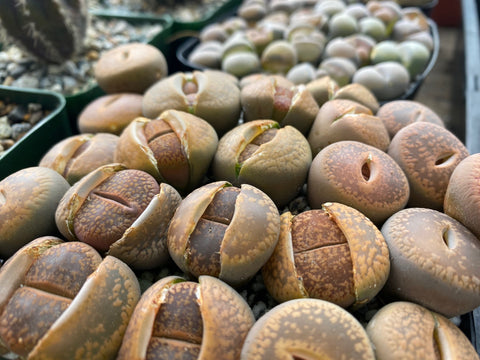
The Lithop Succulent, also known as "living stones," are fascinating succulent plants that mimic the appearance of stones to evade predators in their natural habitat. Growing Lithops from seeds can be a rewarding and fulfilling experience for any plant enthusiast. However, it requires patience, attention to detail, and understanding of their unique growth requirements. In this comprehensive guide, we'll delve into the secrets of successfully growing Lithops from seeds, from seed selection to caring for seedlings.
Understanding Lithops:
Before diving into the seed-growing process, it's essential to have a basic understanding of Lithops. These small, slow-growing succulents are native to the deserts of southern Africa. They have evolved to survive in arid environments by storing water in their fleshy leaves, which are fused together to form a structure resembling a pair of stones.
Lithops have a unique lifecycle, characterized by distinct growth phases. During the summer months, they go dormant, relying on their water reserves to survive. As temperatures cool and days shorten in the fall, Lithops enter their active growth phase, producing new leaves and, eventually, flowers. Understanding these growth cycles is crucial for providing the optimal conditions for germinating and growing Lithops from seeds.
Selecting Seeds:
When it comes to selecting Lithops seeds, quality matters. Look for reputable suppliers who specialize in succulent seeds to ensure you're getting viable seeds from healthy plants. Freshness is key, as seeds lose viability over time. Choose seeds that are plump, firm, and free from mold or damage.
Germination Medium:
Lithops seeds require a well-draining, gritty soil mix to germinate successfully. A blend of coarse sand, perlite, and peat moss or coco coir works well. Avoid using standard potting soil, as it retains too much moisture, increasing the risk of seed rot.
Seed Sowing:
- Prepare your germination medium in small pots or trays with drainage holes.
- Moisten the soil mix slightly before sowing the seeds to provide a stable environment for germination.
- Sprinkle the seeds evenly over the surface of the soil mix, ensuring they are not overcrowded.
- Gently press the seeds into the soil mix to ensure good seed-to-soil contact.
- Cover the seeds lightly with a thin layer of sand or fine grit to protect them from direct sunlight and retain moisture.
Germination Conditions:
Lithops seeds require warmth and moisture to germinate. Place the pots or trays in a warm, brightly lit location, such as a sunny windowsill or under grow lights. Maintain a consistent temperature between 70-80°F (21-27°C) and provide indirect sunlight to promote germination. It's crucial to keep the soil mix evenly moist but not waterlogged during this stage. Use a spray bottle or mister to water gently, avoiding disturbing the seeds.
Germination Time:
Patience is key when germinating Lithops seeds, as they can take anywhere from several weeks to several months to sprout. Keep a close eye on the pots or trays, monitoring moisture levels and adjusting watering as needed. Once the seeds germinate, you'll notice tiny seedlings emerging from the soil surface.
Seedling Care:
As the seedlings grow, gradually acclimate them to brighter light to prevent etiolation or stretching. Provide ample airflow around the seedlings to discourage damping off and fungal diseases. Water the seedlings sparingly, allowing the soil to dry out slightly between watering. Avoid overwatering, as this can lead to root rot and other issues. Be careful about under watering because this can try the seeds.
Transplanting:
Once the seedlings have developed several sets of true leaves and are robust enough to handle, they can be transplanted into individual pots. Use a well-draining soil mix formulated for succulents, and ensure the pots have drainage holes to prevent waterlogged soil. Handle the seedlings carefully, taking care not to damage the delicate roots.
Growing Conditions:
Lithops thrive in bright, indirect light and warm temperatures. Place them in a sunny window or under grow lights where they'll receive at least 6 hours of sunlight per day. During the active growing season in spring and fall, water sparingly, allowing the soil to dry out completely between waterings. Reduce watering during the summer dormancy period to mimic their natural habitat conditions.
Fertilizing:
Fertilize mature Lithops sparingly during the active growing season with a diluted succulent fertilizer, following the manufacturer's recommendations. Avoid fertilizing during the dormancy period, as Lithops do not require additional nutrients during this time.
Pest and Disease Management:
Lithops are relatively pest and disease-resistant, but they can occasionally fall prey to mealybugs, aphids, and fungal infections. Inspect your plants regularly for signs of common succulent pests or disease, such as yellowing leaves, white powdery residue, or unusual growths. Treat any issues promptly with organic pest control methods or fungicides, if necessary.

Conclusion:
Growing Lithops from seeds is a rewarding journey that requires patience, attention to detail, and a bit of trial and error. By understanding their unique growth requirements and providing the optimal conditions for germination and growth, you can enjoy the beauty of these fascinating succulents in your own home or garden. With the tips and techniques outlined in this guide, you'll be well-equipped to unlock the secrets of successfully growing Lithops from seeds. Happy growing!

